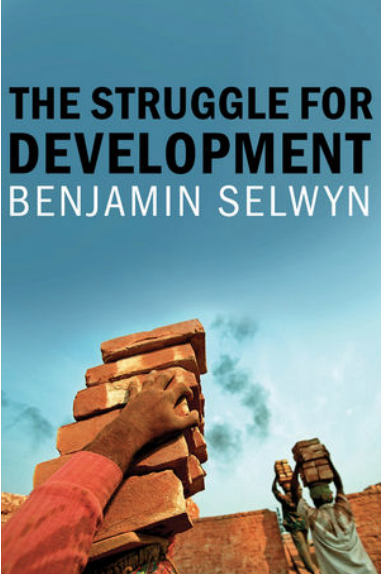A review of The Struggle for Development by Benjamin Selwyn, 2017 Polity Press
The dominant view on the left is that human development can only be achieved through continued economic growth and industrialisation. In contrast, this book describes labour-led development as an alternative approach to what the author calls the Anti-Poverty Consensus. The aim of the book is to “reconceptualise human development as a process of resisting and overcoming capitalist exploitation and to stimulate thinking and actions that contribute to that objective” (page 21).
Labour-led development views society from the perspective of the labouring class rather than from the perspective of capital accumulation or ‘national development’. It takes the classical Marxist view that the working class are the gravediggers of capitalism and that the success of the global socialist revolution develops organically, starting from the day to day struggles of labour against capital (trade union disputes, working to rule, strikes, pickets etc).
Benjamin critiques hard neoliberalism then goes on to expose the holes in the alternative softer, ‘progressive’ capitalism promoted by a range of thinkers. These writers still accept that the prime aim of human development should be economic development, but to a greater or lesser extent accept a key role for the state in regulating this development. Benjamin points out the fundamental contradiction arising from this approach of the “advocacy of labour exploitation and oppression in the name of ameliorating labour’s condition” (page 21).
The Big Lie
Global wealth increased by two thirds in the decade to 2013. But these resources were overwhelmingly captured by the world’s wealthiest people. According to Oxfam[1], since 1980, the poorest half of humanity only gained 12 cents of each dollar of global growth, in contrast the richest 1% gained 27 cents.
The World Bank and others claim that number of the global poor reduced by half in the first 15 years of this millennium. But this is solely based on a reduction in the numbers of those who attempt to exist on less than ‘a dollar a day’. They also welcome the growth of what they call the ‘middle class’, defined as those receiving only between $2 and $10 a day.
These people are “better described as part of the burgeoning global labouring class” (page 33). They are compelled to sell their labour power for wages in order to survive. In the process they are exploited by capital which is able to benefit from surplus value in a manner described by Karl Marx in Capital. This book argues that “capitalism is a social system of exploitation, expropriation and degradation which generates continually evolving forms of poverty.” (page 35).
So, the number of extremely poor may have reduced, but the number of poor in the world is increasing at a faster rate. In addition, finally eliminating global poverty even measured by ‘a dollar a day’ as planned with the Sustainable Development Goals would take at least 200 years even with the high global growth rate of the decade to 2008.
In contrast, empirical evidence is provided to show that, even in a very poor country, using numbers which approximate with those of Bangladesh, extreme poverty could be eliminated by transferring only three per cent of GDP from the richest to the poorest eighths of the population.
Benjamin points out that neoliberalism and the varieties of capital centred development being implemented over the last 30 to 40 years have resulted in “[a]ccumulating resentment among labouring classes [that] represents a social tinderbox, where sparks can detonate mass collective unrest. These revolts can be toxic as well as potentially emancipatory.” (page 18). Whereas the author celebrates collective actions especially in South Africa, Argentina, South Korea and China, he also acknowledges that this resentment can also be turned against other nationalities, ethnic groups or religions. He gives the example of South Africa in April 2016 when this resentment was directed against migrants from other African countries including Nigeria.
Benjamin acknowledges this danger but does not seem to recognise the importance of building effective political parties to focus this resentment against capital nor the dangers of trade union leaders’ failure to lead effective fights against capital rather than just negotiating and compromising the collective struggles of their members. The failure, so far at least, to build effective mass parties of the global labouring classes to successfully fight for labour-led development in the 21st century is our greatest weakness.
Poverty Chains and the World Economy
Benjamin’s second chapter describes what are called global value chains, but may be better understood as outsourcing to the Global South. This is causing de-industrialisation in the north with the famous rust belts of the US which formed at least part of the base for the election of Trump. The classical import of raw materials from the Global South for production in Northern factories has now changed significantly, much global industrial production is now taking place in the south.
This process underpinned the global boom to 2008 as transnational companies gained an increasing share of their profits from overseas subsidiaries (a third of world trade is now within such multinational companies) and other production in the Global South where profits may be a third higher than in the heartlands of capitalism.
Benjamin argues that low wages in the Global South are less due to lower productivity than the socially determined rates of pay in these countries and the inability of trade unions to win progressive wage settlements for their members.
This chapter ends by considering the implications for northern workers. Some authors, for example Samir Amin, claimed that northern workers benefited from the super-exploitation of southern workers and peasants. In contrast Benjamin points out that this exploitation “has exerted colossal downward pressures on worker’s wages across much of the global North” (page 72).
Deepening Exploitation: Capital-Centred Development
Benjamin equates classical Marxism with the self-emancipation of the working class promoted by Karl Marx. He argues that this approach was distorted after the Stalinist counter-revolution of the late 1920s and 1930s. This replaced international socialism with the call for building of socialism in one country.
“The millions of deaths under Stalin and Mao, as a consequence of attempts at accelerated industrialisation” did not deter the leaders of newly independent Africa in the 1960s and this formed the basis of ‘African Socialism’ of, for example, Nyerere in Tanzania and Nkrumah in Ghana. This is also the approach currently being adopted by the ANC in South Africa which means they have accepted privatisation, increased university fees and excused the Marikana Massacre as the price that has to be paid for industrialisation and national development.
Beyond Exploitation; Democratic Development
The last chapter of the book moves on from current labour struggles to consider what could be done if a labouring-class movement was to “conquer political and economic power in a relatively poor country” (page 125). This would be the first stage in building a socialist utopia – which would require global change and the development of a real global social commonwealth.
This global process, Benjamin considers, would take significant time and would require the socialist state to maintain relations in a hostile world still dominated by capitalist states – a process that the author says “may be called intermittent revolution” (page 129).
The new state would move towards decentralised participatory planning with democracy extended into the workplace. This would be based on social ownership of the means of production, allowing the identification and satisfaction of communal needs through worker-community co-operation.
Concerning the banking system, odious debts would be cancelled and capital controls introduced to stop capital flight. Money would be treated as a public resource which should be controlled for the collective good.
Agrarian reform would recognise the need to earn foreign currency from exports, achieve local food security and generate high-quality employment. But Benjamin emphasises the national element for food security and in planning at the highest level. We also need to recognise that taking power in Lesotho or The Gambia would be much more difficult than in Nigeria or South Africa. States are of extremely variable sizes.
Foreign policy would be a delicate balance between peaceful existence with capitalist powers and links with social movements in these countries. Although the later could perhaps be used to apply pressure for non-intervention and positive development assistance. Pressure would also have to be applied to ensure the development of a collective agenda to combat environmental destruction.
The state would campaign for real gender equality, probably using quota in the process and steps would be taken to develop a multi-cultural society which learns and respects all social groups.
These ideas would be proposed for collective discussion and others “will be advanced and debated in the same democratic spirit (page 151). This would be part of the process of re-education that would be necessary to instil a new set of democratic and co-operative values across society, in contrast to the selfish and individualistic values of our current society. This is an aspect that Benjamin rather underplays.
Conclusion
This is only a short book and so does not provide all the answers, but it does provide an overarching analysis of current capitalist production and a strategy, especially for workers in the Global South to adopt, if they are to achieve real development. That is labour-led development where the workers themselves get organised and struggle to increase their own wages and improve their conditions at work.
Benjamin echoes the Communist Manifesto by saying that “Capitalism is an immensely dynamic wealth-generating system. It has established, on a global scale, the basis for a world free from poverty” (page 152). But he also recognises that capitalism “will more certainly wreck the planet, create new forms of mass poverty, and reproduce mega-inequalities than deliver the dream of well-being for all” (page 152). This is almost certain with all varieties of top-down development, in contrast to the labour-led approach that he comprehensively argues for in this book.
The book ends with an emphasis on the links between current struggles of the labouring masses and a future utopian society using the words of an organiser of an occupied factory in Argentina:
“This [process of factory occupation and recovery] is big, because … what one has regarded as a utopia, has become now necessary and possible … If we could take this … to a regional, country, world level … we would be talking of another world” (page 162).
This book provides a strategy for socialists to identify and support, both theoretically and practically, real existing examples of labour-led struggles and development across the world.
by Drew POVEY
[1] World Inequality Report, 2018









